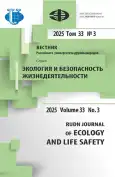Changes in the microbial consortium during the disposal of aged post-fermentation distillery grain using the aerobic composting method
- 作者: Russkikh Y.M.1, Sherstobitov D.N.1, Mashchenko Z.E.1, Ermakov V.V.1, Tupitsyna O.V.1
-
隶属关系:
- Samara State Technical University
- 期: 卷 33, 编号 3 (2025)
- 页面: 342-351
- 栏目: Industrial Ecology
- URL: https://journal-vniispk.ru/2313-2310/article/view/324019
- DOI: https://doi.org/10.22363/2313-2310-2025-33-3-342-351
- EDN: https://elibrary.ru/SWRRHB
- ID: 324019
如何引用文章
详细
The change in the consortium of microorganisms during the disposal of aged post-fermentation distillery grain by aerobic composting using the biopreparation-oil destructor “Lenoil”® SHP containing microorganisms of the genera Ochrobactrum sp. and Acinetobacter sp . has been assessed. In the initial waste, microorganisms of the genera: Acidothermus sp. , Proteus sp. , Pseudomonas sp. , Bacillus sp. , Escherichia sp. , Staphylococcus sp. , and Enterobacter sp. were isolated. After the application of the biopreparation, the following genera of microorganisms were identified: Ochrobactrum sp. , Acinetobacter sp. , Pseudomonas sp. , Bacillus sp. , Escherichia sp. , Staphylococcus sp., and Enterobacter sp. The use of the biopreparation promoted the development of existing microbial populations as well as the introduction of new species. The application of the biopreparation has made it possible to increase the number of microorganisms that contribute to more effective decomposition of organic compounds and reduction of inorganic nitrogen concentration during the disposal of aged post-fermentation distillery grain using the aerobic composting method.
作者简介
Yana Russkikh
Samara State Technical University
Email: yzakieva@gmail.com
ORCID iD: 0000-0002-8653-0744
SPIN 代码: 3817-0653
Ph.D. student of the Graduate School of Biotechnology
244 Molodogvardeyskaya St, Samara, 443100, Russian FederationDanil Sherstobitov
Samara State Technical University
编辑信件的主要联系方式.
Email: shersobitovdn@gmail.com
ORCID iD: 0000-0002-9160-5317
SPIN 代码: 6822-4868
Ph.D. student of the Department of Chemical Technology and Industrial Ecology
244 Molodogvardeyskaya St, Samara, 443100, Russian FederationZinaida Mashchenko
Samara State Technical University
Email: mzinaida@yandex.ru
ORCID iD: 0000-0002-1357-1780
SPIN 代码: 9878-0975
Cand. Sc. (Pharm.), Associate Professor of the Graduate School of Biotechnology
244 Molodogvardeyskaya St, Samara, 443100, Russian FederationVasiliy Ermakov
Samara State Technical University
Email: wassiliy@rambler.ru
ORCID iD: 0000-0001-7720-2418
SPIN 代码: 5201-1408
Cand. Sc. (Tech.), Associate Professor of the Department of Chemical Technology and Industrial Ecology
244 Molodogvardeyskaya St, Samara, 443100, Russian FederationOlga Tupitsyna
Samara State Technical University
Email: olgatupicyna@yandex.ru
ORCID iD: 0000-0003-0638-2700
SPIN 代码: 4203-9529
Dr. Sc. (Tech.), Professor of the Department of Chemical Technology and Industrial Ecology
244 Molodogvardeyskaya St, Samara, 443100, Russian Federation参考
- Dyganova RYa, Belyaeva YuS. Development of method of selection of technologies of alcohol industry waste treatment as an instrument of ecological management. Izvestia of Samara Scientific Center of the Russian Academy of Sciences. 2014;4(2):1728-1736. (In Russ.). EDN: TKPQVX
- Agafonov GV, Zueva NV, Kljuchnikov AI, Yakovlev AN. The comparative characteristic of possible technologies on processing after-ethanol bards. Proceedings of the Voronezh State University of Engineering Technologies. 2012;3(53):107-110. (In Russ.). EDN: PJHXMX
- Kuznecov IN, Rychai NS. The analysis of world experience in processing of alcohol stillage. Proceedings of BSTU. 2010;1(4):294-301. (In Russ.). EDN: SJLBZP
- Vinarov AYu, Kukharenko AA, Nikolajkina NE. Zero-waste biotechnology of ethanol production. Moskva: URAIT; 2019. 272 p. (In Russ.). EDN: XBXFXJ
- Pystin VN, Gubar EV, Tupitsyna OV, Bykov DE, Chertes KL. Waste Disposal and Elimination of the Object of Accumulated Harm in a Specially Protected Natural Area. Ecology and Industry of Russia. 2022;26(5):22-27. (In Russ.). https://doi.org/10.18412/1816-0395-2022-5-22-27 EDN: MCJEYU
- Sherstobitov DN, Ermakov VV, Vasilyev AV, Pystin VN, Bykov DE. Decontamination of aged alcohol bardplaced in ground depositories. Izvestia of Samara Scientific Center of the Russian Academy of Sciences. 2024;24(1):135-140. (In Russ.). https://doi.org/10.37313/1990-5378-2024-26-1-135-140 EDN: LFPWHZ
- Carvalho М, Bento de Carvalho T, Barbosa JB, Teixeira P, Bergogne-Bérézin E. Acinetobacter. Encyclopedia of Food Safety (second edition). 2024;58-67. https://doi.org/10.1016/B978-0-12-822521-9.00212-4.
- Mujumdar Sh, Bhoyar J, Akkar A, Hundekar Sh, Agnihotri N, Jaybhay P, Bhuyan S. Acinetobacter: A versatile plant growth-promoting rhizobacteria (PGPR). Plant-Microbe Interaction - Recent Advances in Molecular and Biochemical Approaches. Volume 1: Overview of Biochemical and Physiological Alteration During Plant-Microbe Interaction. 2023;327-362. https://doi.org/10.1016/B978-0-323-91875-6.00009-8.
- Ryan MP, Pembroke JT. The genus Ochrobactrum as major opportunistic pathogens. Microorganisms. 2020;8(11):1797. https://doi.org/10.3390/microorganisms8111797.
- Korshunova TYu, Kuzina EV, Sharipov DA, Rafikova GF. Bacteria of the genera Acinetobacter and Ochrobactrum in the processes of bioremediation of oil-contaminated objects (review). Theoretical and Applied Ecology. 2021;3:13-20. (In Russ.). https://doi.org/10.25750/1995-4301-2021-3-013-020 EDN: ZBRDON
- Zhao T, Chen P, Zhang L, Zhang L, Gao Ya, Ai Sh, Liu H, Liu X. Heterotrophic nitrification and aerobic denitrification by a novel Acinetobacter sp. TAC-1 at low temperature and high ammonia nitrogen. Bioresource Technology. 2021;339:125620. https://doi.org/10.1016/j.biortech.2021.125620 EDN: UVKFWI
- Wu L, Ding X, Lin Ya, Lu X, Lv H, Zhao M, Yu R. Nitrogen removal by a novel heterotrophic nitrification and aerobic denitrification bacterium Acinetobacter calcoaceticus TY1 under low temperatures. Bioresource Technology. 2022;353:127148. https://doi.org/10.1016/j.biortech.2022.127148 EDN: DHHNVT
- Yang L, He T, Chen M, Zhang M, Yang L, Zheng Ch, Wang C. Excellent phenol removal ability of Acinetobacter guillouiae BY18 under different inorganic nitrogen conditions. Environmental Technology & Innovation. 2024;35:103694. https://doi.org/10.1016/j.eti.2024.103694.
- Tavadze BD, Belokurova EV. The use of bioremediation in laboratory conditions for cleaning soils contaminated with petroleum products and its economic efficiency. Advances in Current natural Sciences. 2024;5:84-89. (In Russ.). https://doi.org/10.17513/use.38270.
- Kobyzeva NV. Local purification of industrial wastewater using the biopreparation “Lenoil” [dissertation]. Ufa: Institute of Biology, Ufa Scientific Center of the Russian Academy of Sciences, 2009. (In Russ.).
- Wen G, Wang T, Li K, Wang H, Wang J, Huang T. Aerobic denitrification performance of strain Acinetobacter johnsonii WGX-9 using different natural organic matter as carbon source: Effect of molecular weight. Water Research. 2019;164:114956. https://doi.org/10.1016/j.watres.2019.114956
- Jiang W, Chen R, Duan Ya, Wang H, Yan H, Shen X, Chen X, Yin Ch, Mao Zh. Isolation of phloridzin-degrading, IAA-producing bacterium Ochrobactrum haematophilum and its effects on the apple replant soil environment. Horticultural Plant Journal. 2023;9(2):199-208. https://doi.org/10.1016/j.hpj.2022.08.010 EDN: LJVOMX
- Feritas JF, Silva DFL, Castro JNF, Agnez-Lima LF. Genomic and phenotypic characterization of novel Ochrobactrum species isolated from Brazilian oil reservoirs: genomic diversity and bioremediation potential. Process Biochemistry. 2025;149:74-84. https://doi.org/10.1016/j.procbio.2024.11.036 EDN: SNNRZS
补充文件









